 So there seems to be a new trend in car rentals—well, maybe it’s an old trend, but I’m just noticing it—where the agencies snag your license and credit card and point you toward the garage telling you to “pick whatever you want” (within your rented category of car, of course). Nice spin on the “or similar” jargon when you’re signing up. And so it went when my wife Thea and I arrived at the Fort Lauderdale airport on a recent nice sunny weekend (a wonderful reprieve from this past New England winter) for a friend’s wedding and a couple of recreational days in Key West.
So there seems to be a new trend in car rentals—well, maybe it’s an old trend, but I’m just noticing it—where the agencies snag your license and credit card and point you toward the garage telling you to “pick whatever you want” (within your rented category of car, of course). Nice spin on the “or similar” jargon when you’re signing up. And so it went when my wife Thea and I arrived at the Fort Lauderdale airport on a recent nice sunny weekend (a wonderful reprieve from this past New England winter) for a friend’s wedding and a couple of recreational days in Key West.
As we rolled our bags toward the economy row, my eyes looked over the various options with the expectation of negotiating an upgrade if required. I saw a Dodge Avenger (“and similar”) in the mid-size row and a Ford Focus (“and similar”) in the compact row. Nothing exciting. Then again, it was a car rental garage. As I glanced down the economy row, I caught sight of the Mazda 2, a strong choice I made when in Florida a couple months ago. Solid car, easy driver, good economy, plenty of car for two of us and our bags for a few days, so that was an easy fallback. I continued looking up and down the row for something interesting and saw the Ford Fiesta (neat-looking car) and then…the Chevy Spark. In bright red.
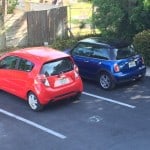 “Why,” I wondered to myself, “am I finding myself walking toward this car?” It’s small. Really small. But yet it has a flirtatious look to it that winks “go ahead, give me a try.” I thought it might be a fun adventure given I would be walking away from it after a few days. I opened the door of its more subdued white sibling beside it and glanced inside. Still way small. I switched on the key and saw it had over 32,000 miles; not the right car for our vacation, no way to know how poorly that little thing was treated over its lifetime. So I walked back to the bright red one, turned on the key and saw…1,580 miles on the odometer. I glanced again at the grey Mazda 2, and it beckoned “you know what you’re gonna get here. Solid. Dependable. Yes boring, but this is about getting there, not about going there.”
“Why,” I wondered to myself, “am I finding myself walking toward this car?” It’s small. Really small. But yet it has a flirtatious look to it that winks “go ahead, give me a try.” I thought it might be a fun adventure given I would be walking away from it after a few days. I opened the door of its more subdued white sibling beside it and glanced inside. Still way small. I switched on the key and saw it had over 32,000 miles; not the right car for our vacation, no way to know how poorly that little thing was treated over its lifetime. So I walked back to the bright red one, turned on the key and saw…1,580 miles on the odometer. I glanced again at the grey Mazda 2, and it beckoned “you know what you’re gonna get here. Solid. Dependable. Yes boring, but this is about getting there, not about going there.”
I chose the bright red Chevy Spark.
Impressions upon getting in and beginning the whole setup procedure (bags, phones, GPS, maps, radio, A/C) were the same as the first: small. As we both sat down it seemed we were almost shoulder-to-shoulder, much less lateral space than in my 2011 GTi. But we weren’t cramped; in fact, we had plenty of elbow space. There’s no center console, but the driver (only) gets a fold-down armrest on the right side of the seat. So space is “adequate,” far more adequate than you’d expect from looking at it.
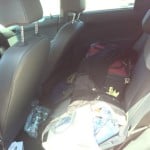
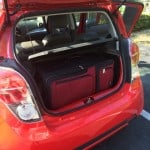 Rear trunk space—such as it is—is really tight. We brought one large and one medium suitcase, and the large suitcase *just* fit inside the rear trunk space, with nothing left over, scraping each side as I dropped it in. The medium bag had to go on the rear seat with our personal carry-ons (purse, my knapsack, laptop bag, etc.), leaving almost no space for any humans back there. If you’re traveling only two-up, or you’re carrying one small child, this car is okay; but if you need to put three (or more) adults in the car with bags, you’re out of luck. So the Spark makes a damn fine two-seater.
Rear trunk space—such as it is—is really tight. We brought one large and one medium suitcase, and the large suitcase *just* fit inside the rear trunk space, with nothing left over, scraping each side as I dropped it in. The medium bag had to go on the rear seat with our personal carry-ons (purse, my knapsack, laptop bag, etc.), leaving almost no space for any humans back there. If you’re traveling only two-up, or you’re carrying one small child, this car is okay; but if you need to put three (or more) adults in the car with bags, you’re out of luck. So the Spark makes a damn fine two-seater.
You sit bolt-upright in the seat; my 6’1″ frame was tall-up in the seat, even with the seat 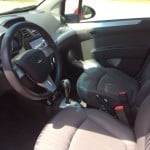 bottom cranked all the way down. It took me several seat adjustments to get comfy, as I prefer a more supine driving position. There’s no fore/aft adjustment on the steering column, only up-and-down. To have adequate spacing with my legs I had to move the seat back. To have adequate spacing on my arms, I had to sit more upright to get closer to the steering wheel. Fortunately, there’s plenty of head room, no scraping. This whole process wasn’t particularly bad or uncomfortable, just unusual for me, and I eventually got used to it. Good visibility outside with lots of glass, and rearward visibility with the outside mirrors was surprisingly good, giving a near 180-degree view across the whole rear of the car.
bottom cranked all the way down. It took me several seat adjustments to get comfy, as I prefer a more supine driving position. There’s no fore/aft adjustment on the steering column, only up-and-down. To have adequate spacing with my legs I had to move the seat back. To have adequate spacing on my arms, I had to sit more upright to get closer to the steering wheel. Fortunately, there’s plenty of head room, no scraping. This whole process wasn’t particularly bad or uncomfortable, just unusual for me, and I eventually got used to it. Good visibility outside with lots of glass, and rearward visibility with the outside mirrors was surprisingly good, giving a near 180-degree view across the whole rear of the car.
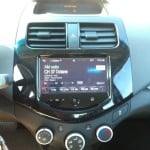 Instrum
Instrum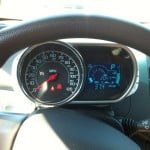 entation was…quirky. The main driver info center was a compact pod mounted on the steering column, not within the dash but directly behind the steering wheel. It moved up and down with the column, and its top was partially obscured by the wheel for this tall guy (but not annoyingly so). Chevy packed a ton of info in this pod, with a clever combo of speedo, LCD gauges (tach, fuel gauge), and driver info (cycling buttons for odo, trip odo, and fuel economy.) There’s no engine gauges (water temp, volts, oil pressure) but honestly, do you need them? I’m quite certain the “idiot” and check-engine lights are more than satisfactory for the people buying this car. The center of the dash panel was dominated by the large-screen “infotainment” center with HVAC controls below that. The upper part of the center dash had an area sticking out with a display that spent five days telling us two things: that the passenger airbag was on (when Thea was in the seat) and the DRLs were on. Somehow I don’t think we really needed a completely separate display system just for that…
entation was…quirky. The main driver info center was a compact pod mounted on the steering column, not within the dash but directly behind the steering wheel. It moved up and down with the column, and its top was partially obscured by the wheel for this tall guy (but not annoyingly so). Chevy packed a ton of info in this pod, with a clever combo of speedo, LCD gauges (tach, fuel gauge), and driver info (cycling buttons for odo, trip odo, and fuel economy.) There’s no engine gauges (water temp, volts, oil pressure) but honestly, do you need them? I’m quite certain the “idiot” and check-engine lights are more than satisfactory for the people buying this car. The center of the dash panel was dominated by the large-screen “infotainment” center with HVAC controls below that. The upper part of the center dash had an area sticking out with a display that spent five days telling us two things: that the passenger airbag was on (when Thea was in the seat) and the DRLs were on. Somehow I don’t think we really needed a completely separate display system just for that…
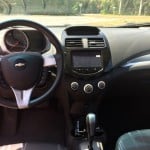 Controls all came easily to hand mostly because they’re all very close. HVAC controls were simple round buttons and knobs in the middle of the center console. (I love a good tactile buttons and detest “soft” screen controls). The steering wheel’s cross-section is not round, it’s more triangular from 2-to-4 and from 8-to-11, quite different than the GTi’s. However, it soon surprisingly came to feel easier on the hand with the flat parts of the triangle in the palm and inside the bent fingers. The only control that required me to lean forward to reach was for the outside electric mirror adjustments, farther up on the extreme left of the dash. The car came with a nice level of equipment, with the aforementioned electric outside mirrors, electric windows, cruise control, A/C, a digital-display AM/FM/XM with USB and 1/8″ accessory jack inputs, and Bluetooth connectivity. The steering wheel was surrounded with control buttons for the cruise (on the left) and stereo controls (on the right). About the only thing I noticed missing were heated seats (this was Florida…). Of course, being a rental it had automatic transmission – a CVT; more on that later. All in all, a nicely equipped car for this price point.
Controls all came easily to hand mostly because they’re all very close. HVAC controls were simple round buttons and knobs in the middle of the center console. (I love a good tactile buttons and detest “soft” screen controls). The steering wheel’s cross-section is not round, it’s more triangular from 2-to-4 and from 8-to-11, quite different than the GTi’s. However, it soon surprisingly came to feel easier on the hand with the flat parts of the triangle in the palm and inside the bent fingers. The only control that required me to lean forward to reach was for the outside electric mirror adjustments, farther up on the extreme left of the dash. The car came with a nice level of equipment, with the aforementioned electric outside mirrors, electric windows, cruise control, A/C, a digital-display AM/FM/XM with USB and 1/8″ accessory jack inputs, and Bluetooth connectivity. The steering wheel was surrounded with control buttons for the cruise (on the left) and stereo controls (on the right). About the only thing I noticed missing were heated seats (this was Florida…). Of course, being a rental it had automatic transmission – a CVT; more on that later. All in all, a nicely equipped car for this price point.
One downside we noticed right away was there’s only a single 12V power plug in this car. In this day and age of GPS, multiple charging phones, etc., that’s quite an oversight. We also travel with a 12V-powered cellular MiFi device for Internet access. We would have liked a 12V port for that somewhere in the rear. Yes, we should have brought a splitter, but these days there should always be more than one power port.
So, having finally gotten settled in, we drove through the parking garage toward the exit across those one-way rental gator teeth (that point of no return). I still had some trepidation; after all, we weren’t just driving the 20 miles to Boca Raton and Delray Beach for the wedding, we were also driving the 200+ miles to Key West, Florida…but the car’s driving responses soon tempered that concern. The departure from airport parking garage is a long circular decline and the initial driving impression of the Spark was favorable: tight responsive steering, decent brakes. The steering ratio was tight, and the car responded well to light adjustments. I had to tap the brakes a few times on the way down and found them responsive but not overly sensitive, powerful enough for the car’s lightweight ~2400 pounds.
Once we hit the road, though, it became obvious that the power was going to be barely adequate; its 84hp, 83lb-ft, 1.2 liters does not leave one with many options for acceleration. Merging onto an interstate was a challenge, requiring all of its noisy four-banger fury. However, once I got used to the idea of maintaining momentum through the corners and merging lanes, it became a fun challenge to time my approach to those lumbering cars in front of me in order to not get squashed by trucks already in the right lane that I was trying to merge into. Just going down the highway at 70 mph, though, the cruise was constantly debating with the CVT on where to be: ~2000 RPM on the flats, with a sudden and noisy jump to over 4000 RPMs (which rarely had much accelerative results anyway) on any kind of incline, even those as light as a rise in highway overpasses. And I decided that on the two-lane Route 1 from Miami to Key West that there’s just no possible way this car has enough gumption to pass anything on a two-lane road unless you’ve got unlimited visibility and a loooooong road.
Noise level was a bit tiring on the highway, even when the engine was at low RPMs. That came not from wind noise but from road/tire noise. The car seems aerodynamically slippery; the only wind noise we noticed was from an occasional side wind gust (which the car certainly noticed). Yet, any time the car was on a grooved concrete highway, the road noise level increased significantly, while road noise level was tolerable when on smooth asphalt. The AM/FM/Bluetooth/XM stereo system is pretty nice, but it’s only marginally capable of good sound level and quality with all the road noise at highway speeds.
The only annoying interior gripe I had was the material of the left side armrest. When cruising on the highway I like to put my left elbow on the armrest while holding the steering wheel in my left hand. However, the rock-hard plastic material of the door armrest meant my elbow got sore after a very short time. That driver’s-only right side armrest is padded, so Chevy, why not go ahead and pad the left side too?
T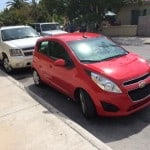 he CVT transaxle offers a few frustrations on its own. That could be due to my own unfamiliarity with CVTs. I like the concept yet have not been pleased with the implementation. The rest of it is due to poor programming for many of its modes. Initial tip-in is a bit aggressive: just a light touch of the throttle pedal results in no response, then you gradually push in the throttle until it JUMPS forward. Maintaining a light touch on the pedal at slow speeds results in a slight jerking fore-and-aft as the transmission and engine tries to decide what to do. The constant debate between the driver’s requests for torque, such as it is, and the CVT’s choices of RPM just never seemed in synch. Another battle I had with the CVT is the consistent RPM on acceleration, to the point where I would lose track of speed as I accelerated and would overshoot the intended level. I guess I’d never noticed how much I’d become accustomed to—or reliant on—the sound of increasing RPMs to indicate I was still accelerating.
he CVT transaxle offers a few frustrations on its own. That could be due to my own unfamiliarity with CVTs. I like the concept yet have not been pleased with the implementation. The rest of it is due to poor programming for many of its modes. Initial tip-in is a bit aggressive: just a light touch of the throttle pedal results in no response, then you gradually push in the throttle until it JUMPS forward. Maintaining a light touch on the pedal at slow speeds results in a slight jerking fore-and-aft as the transmission and engine tries to decide what to do. The constant debate between the driver’s requests for torque, such as it is, and the CVT’s choices of RPM just never seemed in synch. Another battle I had with the CVT is the consistent RPM on acceleration, to the point where I would lose track of speed as I accelerated and would overshoot the intended level. I guess I’d never noticed how much I’d become accustomed to—or reliant on—the sound of increasing RPMs to indicate I was still accelerating.
So all that said…once we hit an urban/suburban environment (like Key West), the Chevy Spark showed its strengths and redeeming driving qualities. It is quite the sprightly car to drive around town. Its tight steering ratio coupled to its light weight really allows you to toss this car around. I found myself taking corners without bothering to brake (just a lift of the throttle), simply because there was no need to and it was fun. And more surprisingly, doing so did not result in scowls from my passenger. I found the brakes to be quite good, saving me in a few close calls when I had to make some quick stops like avoiding Florida’s notoriously-short, potentially-red-camera-laden yellow lights. That tight steering and quick handling even saved us a few times when I had to make “moose avoidance” maneuvers for unexpected lines of stopped traffic; a simple right-left tug on the wheel and a stab of the brakes and we were in the next lane, no muss no fuss — and again with minimal scowls.
Even more fun, the Spark’s ability to make quick tight turns prompted Thea to note, “It really makes nice U-turns…” We found ourselves nicknaming it “Sparky”. Yes, we’re very clever, she and I. 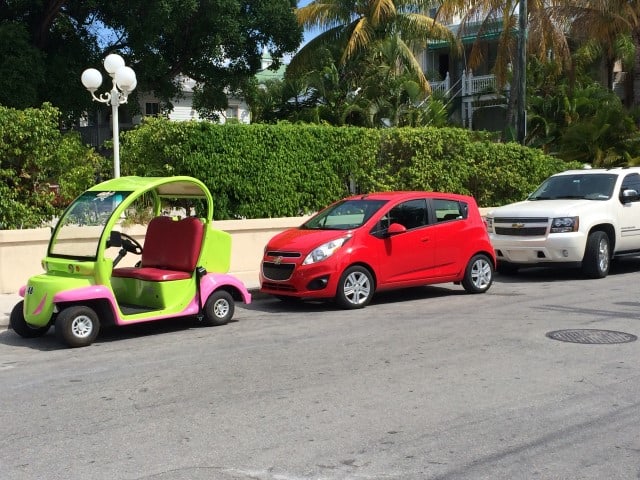
The Spark’s number one redeeming quality is that it will fit ANYWHERE. While navigating the tight streets of Key West, we had absolutely no problem parking it in the tightest of spaces. I could adeptly slide the little car into parallel parking spaces designed for the town’s (in)famous electric “egg cars.” When encountering large opposing traffic on the narrow streets, we just moved over to the right and breezed right by. Finding a parking spot at the Laura Quinn Wild Bird Sanctuary, which was basically in the trees lined along a gravel road, was no problem: find a little spot in the treeline and slid right in. Had we driven to Key West in our diesel Ford Excursion we may have well left that truck in Marathon (FL) and hitch-hiked the rest of the way. The Chevy Spark gave us travel options on that island that we would not have had otherwise.
As for fuel economy, it was not awesome but not terrible. The car runs on the cheapest fuel (87 octane) and provided an overall fuel economy of 38 mpg for the trip. That ranged from a low 36 mpg in mixed city/highway driving to a high of 39 mpg on the Interstate (70 mph) and along Route 1 to Key West (55-ish mph average). It has only a 9 gallon fuel tank; it was kinda neat being able to fill the car for less than $30 but it still gave us plenty of range to find a Dairy Queen and bathroom stop before it ran out of fuel. Honestly, though, I expected a bit better fuel economy from such a lightweight 1.2L car.
Vacation was soon over and we were back to home base, jumping in the VW GTi at the airport; it was like slipping on a well-worn baseball glove. That made me realize that while the Chevy Spark is a good car in its own environment it’s not necessarily a very good all-purpose car. My personal mission for a car is that of a daily commute5r in mixed suburbia and highways, with an occasional longer highway trip tossed in. Comparing my 36,000-mile soon-to-be-off-lease ~$13,000 VW GTi (that gets a combined observed 28 mpg) to a brandy-new ~$13,000 Chevy Spark (with a combined observed 36 mpg), I find it’s really not that hard of a decision…sorry Chevy.
However, if my mission was almost exclusively urban/city driving, with very limited if any longer trips (or even better, I lived in Key West), then the Chevy Spark would be right up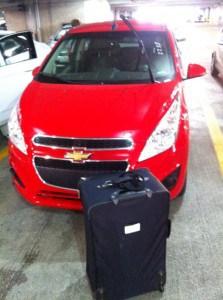 there on my shopping list. It’s a car clearly designed for the city, built for that environment, one that reminds me a lot of my very first new car, the 1983 Rabbit GTi (which was about the same size and came with all of 90hp). I probably would not want to drive to Cleveland in the Chevy Spark – certainly not while in the back seat – but it would be a car of preference for tight urban/suburban/city streets without the pretensions (and with a lot more functionality) than the Smart ForTwo, for a lot less money.
there on my shopping list. It’s a car clearly designed for the city, built for that environment, one that reminds me a lot of my very first new car, the 1983 Rabbit GTi (which was about the same size and came with all of 90hp). I probably would not want to drive to Cleveland in the Chevy Spark – certainly not while in the back seat – but it would be a car of preference for tight urban/suburban/city streets without the pretensions (and with a lot more functionality) than the Smart ForTwo, for a lot less money.
Though I do admit there was more than a tinge of regret, looking back as we were walking away from it at the airport…
The LS Manual MSRP starts at $12,170


